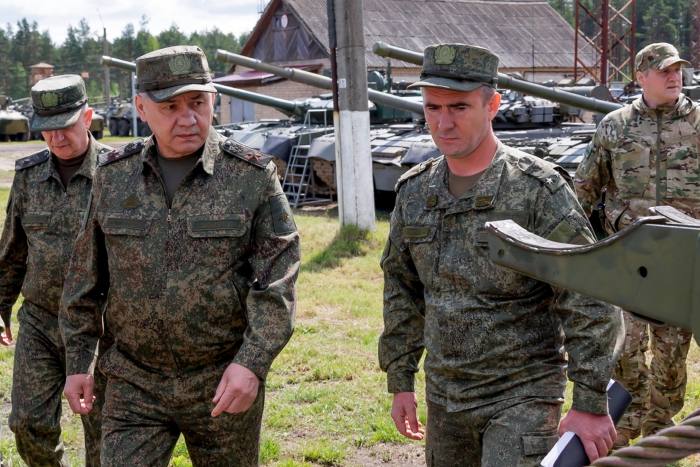Ukrainian forces intensified their counter-offensive over the weekend and claimed to have liberated two villages, after president Volodymyr Zelenskyy for the first time acknowledged that an operation is under way to liberate parts of the Russian-occupied territories in the south-east of the country.
The Ukrainian army said on Sunday that it had liberated Blahodatne and Neskuchne, two villages in south of Donetsk region — which would mark a break in at least one layer of Russian defences south of Velyka Novosilka where counter-attacks were reported last week. Ukrainian soldiers posted a video of themselves raising the country’s national flag on a building in Blahodatne and holding their brigade’s flag in Neskuchne.
Kyiv has long been reluctant in admitting that the counter-offensive had started. But on Saturday, Zelenskyy said that “the counteroffensive and respective defensive actions are under way”.
“It’s important that Russia fully feels . . that they don’t have much time left,” Zelenskyy said during a news conference with Canadian prime minister Justin Trudeau.
The Ukrainian leader said that the aim is to liberate some 18 per cent of occupied territory in south-eastern regions, but that no further details would be made public about the offensive.
Moscow did not immediately comment on the claims.
On Saturday, the Russian defence ministry said Ukraine had yet to break through its defensive lines and claimed to have destroyed some of Kyiv’s advanced western-manufactured weaponry, including German-made Leopard tanks, US infantry fighting vehicles and a French howitzer.
The defence ministry has published several videos in recent days claiming to show successful strikes from helicopters and drones on Ukrainian armoured vehicles.
Kyiv has not acknowledged any losses.


The Russian defence ministry spokesman who made the claims, Igor Konashenkov, is known for making exaggerated claims, including capturing the same town multiple times — and has come under rare public criticism from Russian pro-war hardliners.
On Sunday, state television showed footage of Sergei Shoigu, Russia’s defence minister, handing out the Hero of Russia Gold Star medal, the country’s highest military honour, to two soldiers said to have destroyed several of Ukraine’s tanks and infantry fighting vehicles. The ministry did not say where the men had fought or which armoured units they had supposedly destroyed.
Russian president Vladimir Putin on Friday said the Ukrainian counter-offensive had been under way for five days and made a rare admission of his country lacking sufficient modern weaponry — while claiming that his forces were so far resisting the attacks.
But the defence ministry is still struggling to bring some of Russia’s own forces under its control — with a long-running spat between Shoigu and the paramilitary group Wagner deepening on Sunday.
Yevgeny Prigozhin, Wagner’s founder, said the group would resist any efforts to make it subordinate to the defence ministry after Shoigu signed a decree requiring all of Russia’s patchwork volunteer battalions and irregular forces to sign army contracts.
Prigozhin said Wagner would continue to answer to Putin alone because Shoigu “can’t run military units properly”. But the paramilitary chief named a different general, Sergei Surovikin, as someone he could work with.
The rare public infighting has clouded one of Russia’s rare battlefield successes after Wagner and the army clashed over who deserved the most credit for capturing the symbolically important town of Bakhmut last month. The former commander of an army unit in that region said this week that Wagner fighters had tortured him, forced him to record a video confession and that they stole several armoured units from the Russian forces.
The intensified Ukrainian attacks come after Tuesday’s Kakhovka dam breach, which triggered catastrophic flooding in both Ukrainian and Russian-held territories along the Dnipro river in the southern Kherson region. The flood has narrowed the frontline by preventing Ukrainian forces from conducting offensive operations there.


Hanna Maliar, the Ukrainian deputy defence minister, said on Sunday that Russia was already redeploying its “most combat-capable units” from the Kherson region to other frontline areas.
Kyiv has accused Russian sabotage groups of blowing up the dam — a claim which Moscow denies.
Nearly 3,000 people have so far been evacuated from the towns under Ukrainian control, with officials saying that the water started receding on Sunday. The destruction was worse on the eastern bank occupied by Russia, where evacuations started late and with insufficient resources.
Ihor Klymenko, Ukraine’s interior affairs minister, said on Sunday that the flooding killed at least five people on Ukrainian controlled territory and an estimated at least 14 casualties in Russian-occupied parts of Kherson region. Another 35 people were missing, including seven children, Klymenko said.
The governor of the Ukrainian Kherson region, Oleksandr Prokudin, said three civilians were killed and 10 people injured on Sunday, including two law enforcement officers, after Russian forces fired at a rescue boat which had evacuated people from the Russian occupied part.
Credit: Source link















